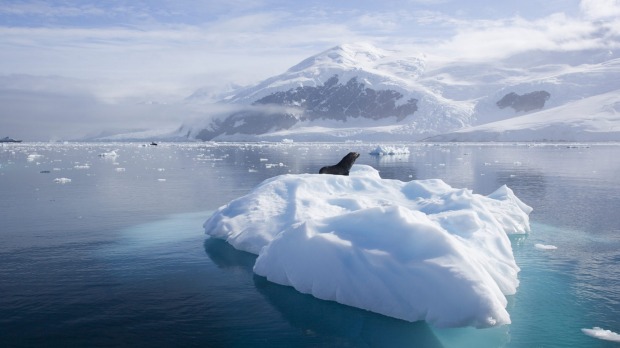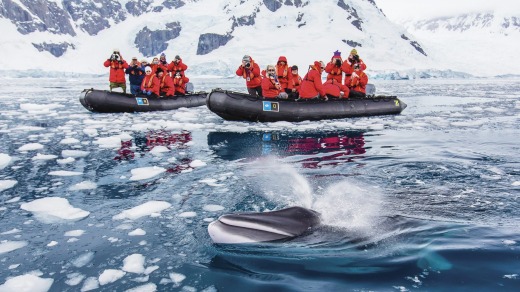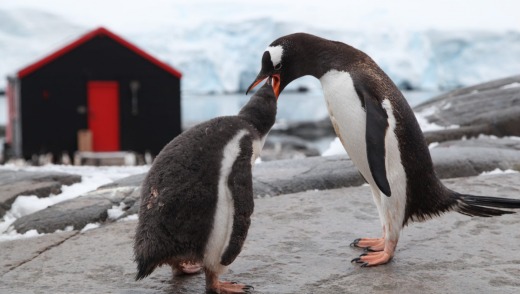
Once remote, Antarctica has become tantalisingly accessible, writes Kerry van der Jagt.
The pod of killer whales surface as one, dorsal fins rising and falling in a slow waltz, frigid breath glowing like gossamer in the early-morning sun. In the distance the glistening edge of a glacier clutches at a cobalt-blue sky, the line of whales forming shadow puppets against a curtain of white ice.
As the pod cuts across the strait a lone Zodiac sits in wait, its black-clad pilot manoeuvring the marksman into position. Braced against the bow the shooter lifts his crossbow, takes careful aim and fires, the arrow tracing a perfect line towards its target.

Standing on the bow of National Geographic Explorer, I instinctively squeeze my eyes shut, a blast from the ship's horn signalling that the dart has found its mark. Though it's too small to see the matchbox-sized tag, which clings like a limpet to the whale's dorsal fin, the transmitter will relay vital information back to the researchers - how deep the whale dives, where it feeds, and how far it travels.
"Killer whales are the ocean's top predators," explains Dr John Durban, after rejoining us on the bow. "So the more we learn about them, the more we'll understand the ecology of Antarctica as a whole."
After 10 seasons in Antarctica, Durban, together with his colleague, Dr Bob Pitman, has identified different sub-groups. "It's long been thought there is only one species of killer whale, but our research indicates there are five different forms, possibly representing four different species."

This is cutting-edge science, and as passengers on National Geographic Explorer we are invited to participate by uploading our killer-whale photographs to a database that tracks whale movements. To date, 30,000 identification photos have been added, many provided by "citizen scientists" such as ourselves.
Since the Heroic Age of Antarctic exploration, which was as much about science as flag-planting, people have been drawn here by curiosity - about this frozen land and about humanity. In the centenary year of Ernest Shackleton's 1914-17 Imperial Trans-Antarctic Expedition, we're here for similar reasons - as a nod to the great man himself, and to learn for myself what books can only hint it.
My journey began five days earlier in Ushuaia, when 148 passengers, an expedition team of National Geographic photographers and naturalists, and two of the world's leading experts on killer whales boarded the ice-class expedition ship National Geographic Explorer for the 12-day journey to the Antarctic Peninsula. The founder, Lars-Eric Lindblad, was an early Antarctic expeditioner and has been defined by many as the father of ecotourism.
Lindblad Expeditions are partners with National Geographic, an alliance that is a bonus both for the environment and passengers.
While the past four expeditions have had killer-whale researchers on board, on the next trip the documentary team from Chasing Ice will install time-lapse cameras to record changes on melting glaciers.
From Ushuaia it takes two days to cross the dreaded Drake Passage. Acupressure bands and scopolamine patches become the currency of the sea, as the Explorer steams out of Ushuaia Harbour. Some passengers seek solace in their cabins, while others head to the bar in search of medication of a different kind.
I take refuge in the bridge, where I find Captain Kruess hunched over his charts. While other ships remain grounded in the harbour, the state-of-the-art Explorer, equipped with stabilisers and military-grade sonar, plots a new course and finds a smooth passage through the storm (we will pay the dreaded Drake Tax on our return).
Built with luxury as well as function in mind, the Explorer's interior is surprisingly plush. The public areas are spacious, including a lounge and bar, spa, fitness centre, library, chart room and a selection of dining options. Cabins are elegantly appointed with large picture windows (some cabins have private balconies), a flat-panel television for movies or documentaries, and ample desk and storage space.
During the crossing I spend hours on deck, filling my notebook with sightings - storm petrel, snow petrel, Antarctic tern - mouthing these wintry words, blinking back tears when I spot my first wandering albatross. Evenings are given to guest speakers, from Pulitzer Prize-winning author Edward Larson, who talks about his book An Empire of Ice: Scott, Shackleton, and the Heroic Age of Antarctic Science, to naturalists who talk on topics ranging from krill to climate change. "Krill is the engine that powers the entire Antarctic ecosystem, explains Marylou Blakeslee. "Yet over the last 30 years stocks may have declined by as much as 80 per cent, probably because of a fall in the amount of sea ice."
By day two we reach Point Wild, an ice-covered crag of land on Elephant Island. Standing on the bow, eyes stinging from sleet and snow, we squint, trying to make out the scrap of beach beneath the jagged black rocks. Almost 100 years ago another boat looked for a landing site on this same treacherous coast. Following the loss of their ship the Endurance due to Weddell Sea pack ice, the 28 men of Shackleton's expedition, including photographer Frank Hurley, sailed to Elephant Island in open lifeboats. How they survived here for 135 days, while Shackleton set off to South Georgia on a rescue mission, is the stuff of legend.
Unable to land due to rough seas we steam further south, crossing Bransfield Strait and entering Antarctic Sound. It's a frigid minus-15 degrees when we step ashore on Brown Bluff, an extinct volcano on the peninsula's north-eastern tip. With sleet tearing at our faces we crouch on the snow-covered beach watching juvenile adelie penguins bustling about like commuters running late for their train. "Numbers are secure here," explains our guide, Stephanie, as the youngsters teeter on the water's edge daring each other to jump first. "But on the western side of the peninsula adelies are decreasing due to the declining ice and krill."
The next morning I wake to the Antarctica of my dreams - a garden of ice sculptures adrift in a pool of indigo. Some are as big as cathedrals, others are shaped like glass swans or mermaids, all look like they've been chiselled from blue topaz. I stand on the bow drinking it in, knowing that when I'm old and grey and have trouble remembering things, I will never forget this.
On a Zodiac ride through Bransfield Straight we see humpbacks sleeping, as motionless as logs, their puffy snuffles blowing clouds into the sky. In Mikkelsen Harbour we kayak through a churning slushie, teams of porpoising penguins leaping like salmon beside us. Other moments are brutal - a leopard seal beating a gentoo against an iceberg, a skua bird snatching an adelie from its screaming mother.
One afternoon we find the entrance to the Weddell Sea blocked by pack-ice, the same type that held the Endurance in a frozen grip for 10 months. Although the Explorer puts on a dramatic ice-breaking performance, we make little headway and are forced to turn around. A century later, the power of this frozen land remains the same.
Shackleton once wrote: "We all have our own White South." I find mine, not only in the bucket-list of wildlife encounters, but also in the ice itself.
Drifting across Paradise Harbour, with the Zodiac's motor cut, I hear for the first time the orchestra of the ice - the clatter of crystals falling, the moan of giant plates rubbing, the groan of glaciers calving. The acclaimed British composer Peter Maxwell Davies, who visited Antarctica for inspiration for his composition Antarctic Symphony, described the sounds as "the mightiest, gentlest, longest whisper ever".
One night, too restless to sleep, I join Durban on the bow. He tells me that killer whales are long-lived, up to 90 years, and that like humans they live in multi-generational family groups. "As many as four generations of killer whales will live together," he says. "Like humans, this allows them to pass on an astonishing amount of cultural knowledge."
Overhead, a full moon bathes the ocean in an electric-blue light, while in the distance a lone humpback dives, flicking its tail into the air like a carefree teenager. A century ago, Shackleton fought against Antarctica; today, the battle is to save Antarctica, but thanks to scientists such as Durban and guides such as Blakeslee, a new generation of travellers is returning home, prepared to take up the fight for Earth's last pristine places.
The writer was a guest of Lindblad Expeditions and LAN Airlines
TRIP NOTES
GETTING THERE
LAN Airlines now operates seven one-stop flights each week from Sydney to Santiago, Chile, with onward connections to Ushuaia, Argentina, the gateway to Antarctica. LAN also offers non-stop flights between Sydney and Santiago every Monday, Wednesday and Saturday in a codeshare partnership with oneworld partner airline Qantas. See lan.com
CRUISING THERE
Lindblad Expeditions offers a range of departure dates aboard National Geographic Explorer from November 2014 to February 2015. Rates begin at $12,350 for a 12-day expedition to Antarctica, or $20,720 for a 22-day expedition to Antarctica, South Georgia and the Falklands, a person in a category-1 cabin based on double occupancy. During 2014-15 each guest will receive a custom-designed parka with centennial badge, a copy of Endurance: Shackleton's Incredible Voyage, and the opportunity to toast Shackleton, Hurley and their fellow explorers with the same whisky favoured on the original voyage. See expeditions.com.
MORE INFORMATION
expeditions.com.
FIVE MORE ANTARCTIC ADVENTURES
POLAR PADDLING
Don't miss kayaking on Mikkelsen Harbour and Danco Island. The extremely stable double kayaks allow passengers to enjoy the surroundings without the noise associated with Zodiacs.
POST A LETTER
Port Lockroy in Palmer Archipelago is a post office and museum run by the UK Antarctic Heritage Trust. Stock up on all the penguin paraphernalia you didn't know you needed.
TAKE THE PLUNGE
The polar plunge has become a rite of passage for many travellers to Antarctica. Once you decide to take the leap of faith only one question remains - feet or head first?
TAKE A HIKE
The steep climb to the top of Danco Island offers great views over Neko Harbour, but the opportunity to slide back down on your backside is what makes it worthwhile.
PENGUINS AT PLAY
For the best show in town, pull up some ice and wait for the games to begin. Juvenile adelie, gentoo and chinstrap penguins all excel at diving, chasing, hide-and-seek and peck-the-bootlace.